Financial Analysis and Performance Evaluation: Sainsbury & Tesco
VerifiedAdded on 2023/01/10
|19
|4499
|1
Report
AI Summary
This report provides a financial analysis of Sainsbury and Tesco, evaluating their financial performance and position over a four-year period. It examines profitability ratios, including Return on Capital Employed (ROCE), Return on Equity (ROE), Gross Profit Margin, and Net Profit Margin, revealing trends and comparing the companies' performances. The analysis further delves into efficiency ratios, such as asset turnover, inventory turnover, and receivables turnover, highlighting the effectiveness of management in utilizing assets and managing working capital. Solvency ratios, specifically the debt-to-equity ratio, are also assessed to determine the financial risk and capital structure of both companies. The report offers insights into the strengths and weaknesses of each company, providing a comprehensive overview of their financial health and strategic positions.
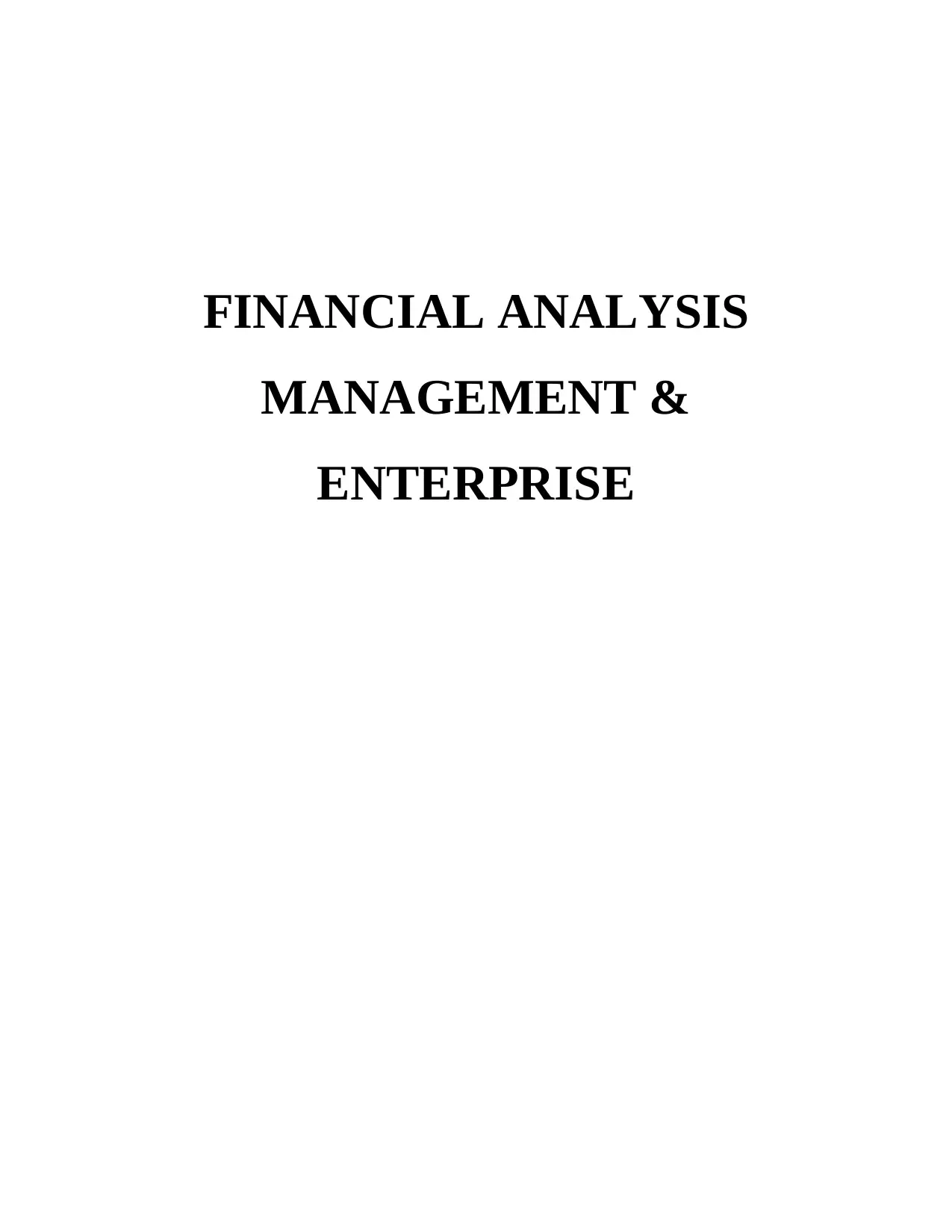
FINANCIAL ANALYSIS
MANAGEMENT &
ENTERPRISE
MANAGEMENT &
ENTERPRISE
Paraphrase This Document
Need a fresh take? Get an instant paraphrase of this document with our AI Paraphraser
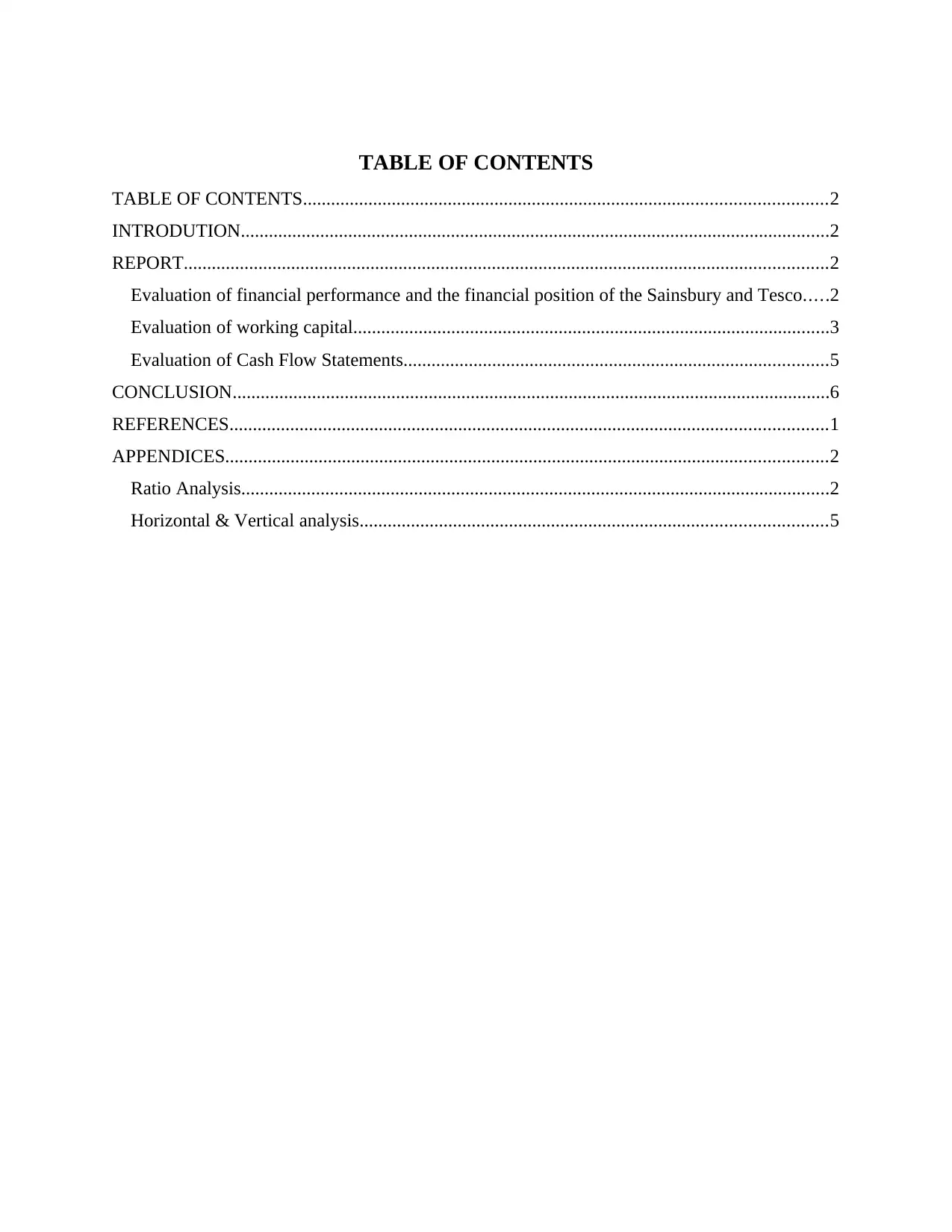
TABLE OF CONTENTS
TABLE OF CONTENTS................................................................................................................2
INTRODUTION..............................................................................................................................2
REPORT..........................................................................................................................................2
Evaluation of financial performance and the financial position of the Sainsbury and Tesco.....2
Evaluation of working capital......................................................................................................3
Evaluation of Cash Flow Statements...........................................................................................5
CONCLUSION................................................................................................................................6
REFERENCES................................................................................................................................1
APPENDICES.................................................................................................................................2
Ratio Analysis..............................................................................................................................2
Horizontal & Vertical analysis....................................................................................................5
TABLE OF CONTENTS................................................................................................................2
INTRODUTION..............................................................................................................................2
REPORT..........................................................................................................................................2
Evaluation of financial performance and the financial position of the Sainsbury and Tesco.....2
Evaluation of working capital......................................................................................................3
Evaluation of Cash Flow Statements...........................................................................................5
CONCLUSION................................................................................................................................6
REFERENCES................................................................................................................................1
APPENDICES.................................................................................................................................2
Ratio Analysis..............................................................................................................................2
Horizontal & Vertical analysis....................................................................................................5
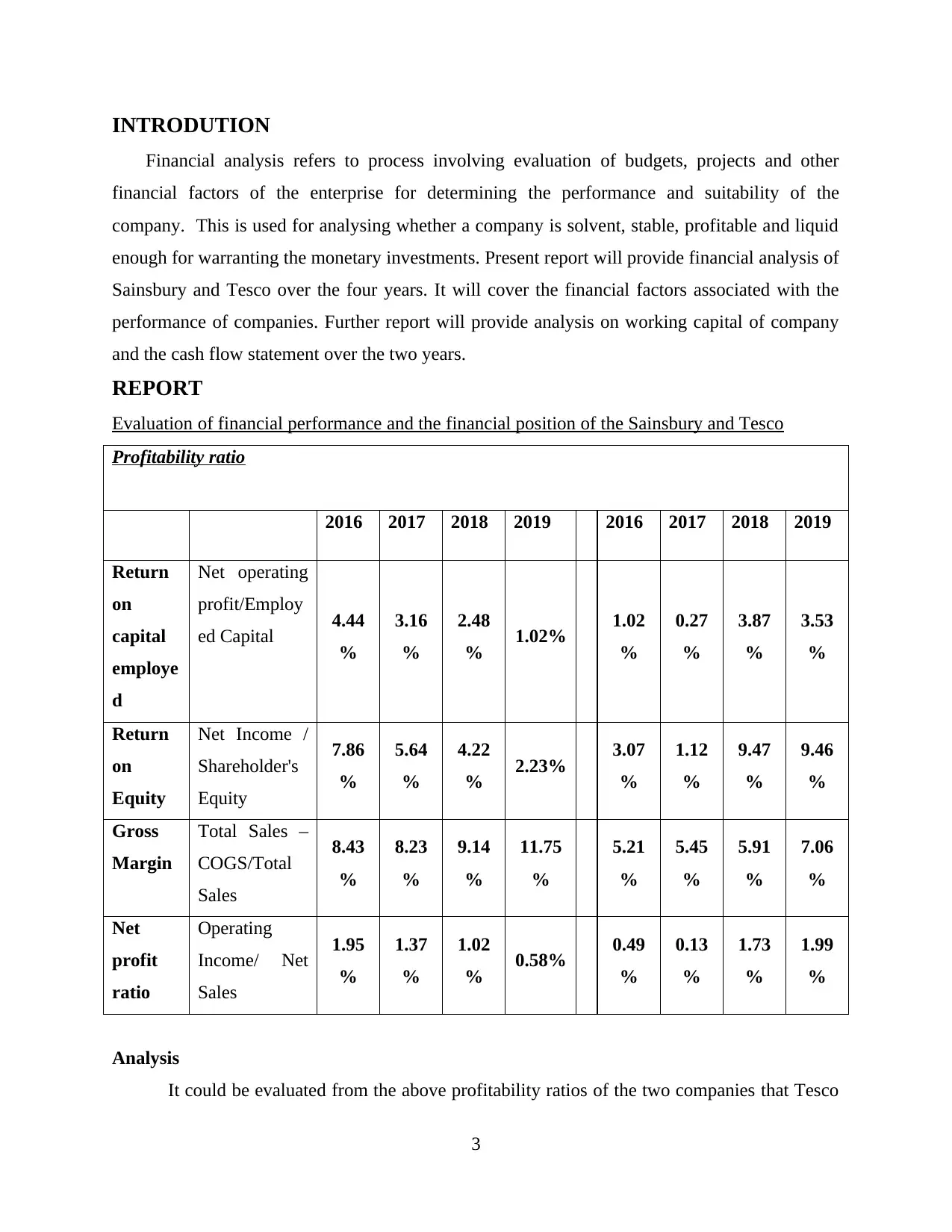
INTRODUTION
Financial analysis refers to process involving evaluation of budgets, projects and other
financial factors of the enterprise for determining the performance and suitability of the
company. This is used for analysing whether a company is solvent, stable, profitable and liquid
enough for warranting the monetary investments. Present report will provide financial analysis of
Sainsbury and Tesco over the four years. It will cover the financial factors associated with the
performance of companies. Further report will provide analysis on working capital of company
and the cash flow statement over the two years.
REPORT
Evaluation of financial performance and the financial position of the Sainsbury and Tesco
Profitability ratio
2016 2017 2018 2019 2016 2017 2018 2019
Return
on
capital
employe
d
Net operating
profit/Employ
ed Capital 4.44
%
3.16
%
2.48
% 1.02% 1.02
%
0.27
%
3.87
%
3.53
%
Return
on
Equity
Net Income /
Shareholder's
Equity
7.86
%
5.64
%
4.22
% 2.23% 3.07
%
1.12
%
9.47
%
9.46
%
Gross
Margin
Total Sales –
COGS/Total
Sales
8.43
%
8.23
%
9.14
%
11.75
%
5.21
%
5.45
%
5.91
%
7.06
%
Net
profit
ratio
Operating
Income/ Net
Sales
1.95
%
1.37
%
1.02
% 0.58% 0.49
%
0.13
%
1.73
%
1.99
%
Analysis
It could be evaluated from the above profitability ratios of the two companies that Tesco
3
Financial analysis refers to process involving evaluation of budgets, projects and other
financial factors of the enterprise for determining the performance and suitability of the
company. This is used for analysing whether a company is solvent, stable, profitable and liquid
enough for warranting the monetary investments. Present report will provide financial analysis of
Sainsbury and Tesco over the four years. It will cover the financial factors associated with the
performance of companies. Further report will provide analysis on working capital of company
and the cash flow statement over the two years.
REPORT
Evaluation of financial performance and the financial position of the Sainsbury and Tesco
Profitability ratio
2016 2017 2018 2019 2016 2017 2018 2019
Return
on
capital
employe
d
Net operating
profit/Employ
ed Capital 4.44
%
3.16
%
2.48
% 1.02% 1.02
%
0.27
%
3.87
%
3.53
%
Return
on
Equity
Net Income /
Shareholder's
Equity
7.86
%
5.64
%
4.22
% 2.23% 3.07
%
1.12
%
9.47
%
9.46
%
Gross
Margin
Total Sales –
COGS/Total
Sales
8.43
%
8.23
%
9.14
%
11.75
%
5.21
%
5.45
%
5.91
%
7.06
%
Net
profit
ratio
Operating
Income/ Net
Sales
1.95
%
1.37
%
1.02
% 0.58% 0.49
%
0.13
%
1.73
%
1.99
%
Analysis
It could be evaluated from the above profitability ratios of the two companies that Tesco
3
⊘ This is a preview!⊘
Do you want full access?
Subscribe today to unlock all pages.

Trusted by 1+ million students worldwide
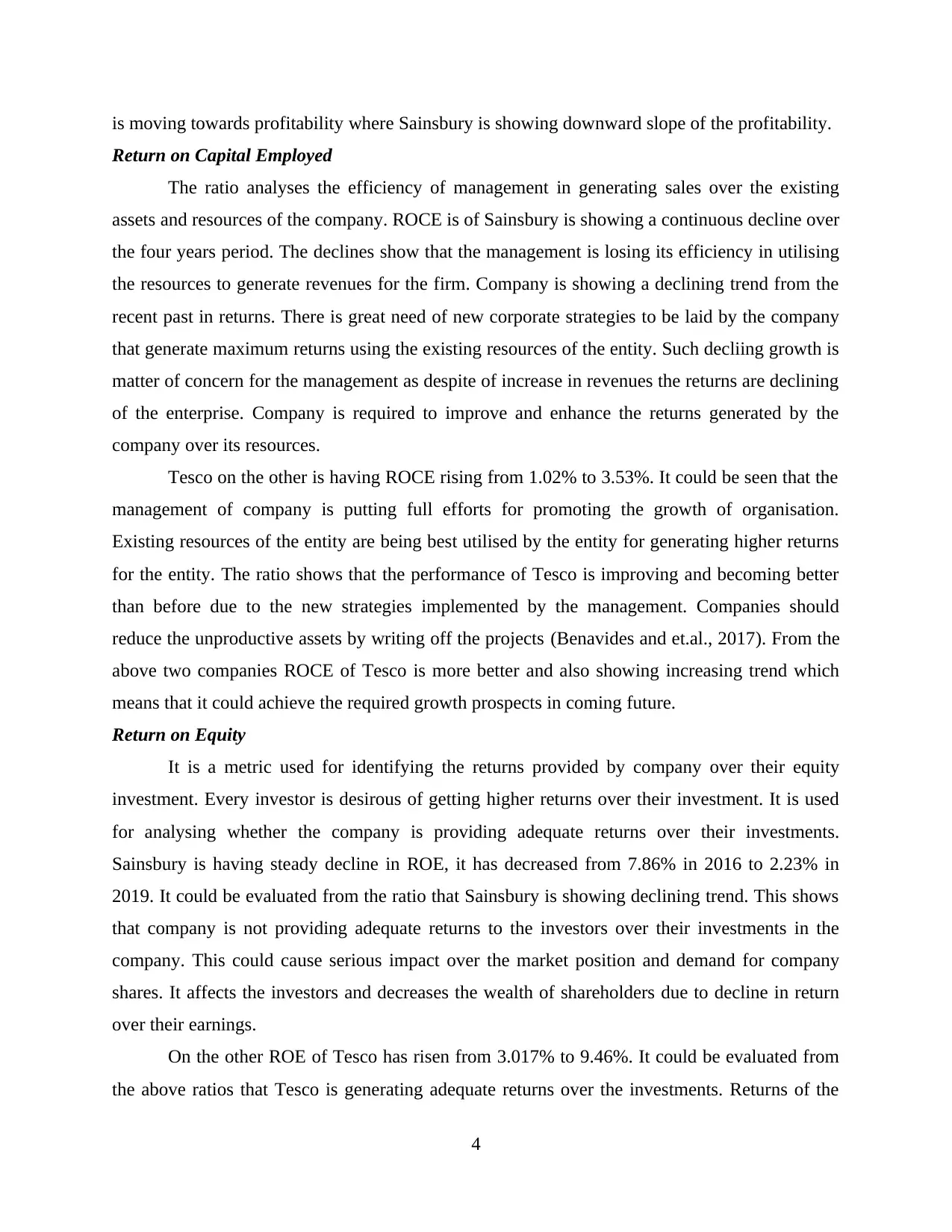
is moving towards profitability where Sainsbury is showing downward slope of the profitability.
Return on Capital Employed
The ratio analyses the efficiency of management in generating sales over the existing
assets and resources of the company. ROCE is of Sainsbury is showing a continuous decline over
the four years period. The declines show that the management is losing its efficiency in utilising
the resources to generate revenues for the firm. Company is showing a declining trend from the
recent past in returns. There is great need of new corporate strategies to be laid by the company
that generate maximum returns using the existing resources of the entity. Such decliing growth is
matter of concern for the management as despite of increase in revenues the returns are declining
of the enterprise. Company is required to improve and enhance the returns generated by the
company over its resources.
Tesco on the other is having ROCE rising from 1.02% to 3.53%. It could be seen that the
management of company is putting full efforts for promoting the growth of organisation.
Existing resources of the entity are being best utilised by the entity for generating higher returns
for the entity. The ratio shows that the performance of Tesco is improving and becoming better
than before due to the new strategies implemented by the management. Companies should
reduce the unproductive assets by writing off the projects (Benavides and et.al., 2017). From the
above two companies ROCE of Tesco is more better and also showing increasing trend which
means that it could achieve the required growth prospects in coming future.
Return on Equity
It is a metric used for identifying the returns provided by company over their equity
investment. Every investor is desirous of getting higher returns over their investment. It is used
for analysing whether the company is providing adequate returns over their investments.
Sainsbury is having steady decline in ROE, it has decreased from 7.86% in 2016 to 2.23% in
2019. It could be evaluated from the ratio that Sainsbury is showing declining trend. This shows
that company is not providing adequate returns to the investors over their investments in the
company. This could cause serious impact over the market position and demand for company
shares. It affects the investors and decreases the wealth of shareholders due to decline in return
over their earnings.
On the other ROE of Tesco has risen from 3.017% to 9.46%. It could be evaluated from
the above ratios that Tesco is generating adequate returns over the investments. Returns of the
4
Return on Capital Employed
The ratio analyses the efficiency of management in generating sales over the existing
assets and resources of the company. ROCE is of Sainsbury is showing a continuous decline over
the four years period. The declines show that the management is losing its efficiency in utilising
the resources to generate revenues for the firm. Company is showing a declining trend from the
recent past in returns. There is great need of new corporate strategies to be laid by the company
that generate maximum returns using the existing resources of the entity. Such decliing growth is
matter of concern for the management as despite of increase in revenues the returns are declining
of the enterprise. Company is required to improve and enhance the returns generated by the
company over its resources.
Tesco on the other is having ROCE rising from 1.02% to 3.53%. It could be seen that the
management of company is putting full efforts for promoting the growth of organisation.
Existing resources of the entity are being best utilised by the entity for generating higher returns
for the entity. The ratio shows that the performance of Tesco is improving and becoming better
than before due to the new strategies implemented by the management. Companies should
reduce the unproductive assets by writing off the projects (Benavides and et.al., 2017). From the
above two companies ROCE of Tesco is more better and also showing increasing trend which
means that it could achieve the required growth prospects in coming future.
Return on Equity
It is a metric used for identifying the returns provided by company over their equity
investment. Every investor is desirous of getting higher returns over their investment. It is used
for analysing whether the company is providing adequate returns over their investments.
Sainsbury is having steady decline in ROE, it has decreased from 7.86% in 2016 to 2.23% in
2019. It could be evaluated from the ratio that Sainsbury is showing declining trend. This shows
that company is not providing adequate returns to the investors over their investments in the
company. This could cause serious impact over the market position and demand for company
shares. It affects the investors and decreases the wealth of shareholders due to decline in return
over their earnings.
On the other ROE of Tesco has risen from 3.017% to 9.46%. It could be evaluated from
the above ratios that Tesco is generating adequate returns over the investments. Returns of the
4
Paraphrase This Document
Need a fresh take? Get an instant paraphrase of this document with our AI Paraphraser
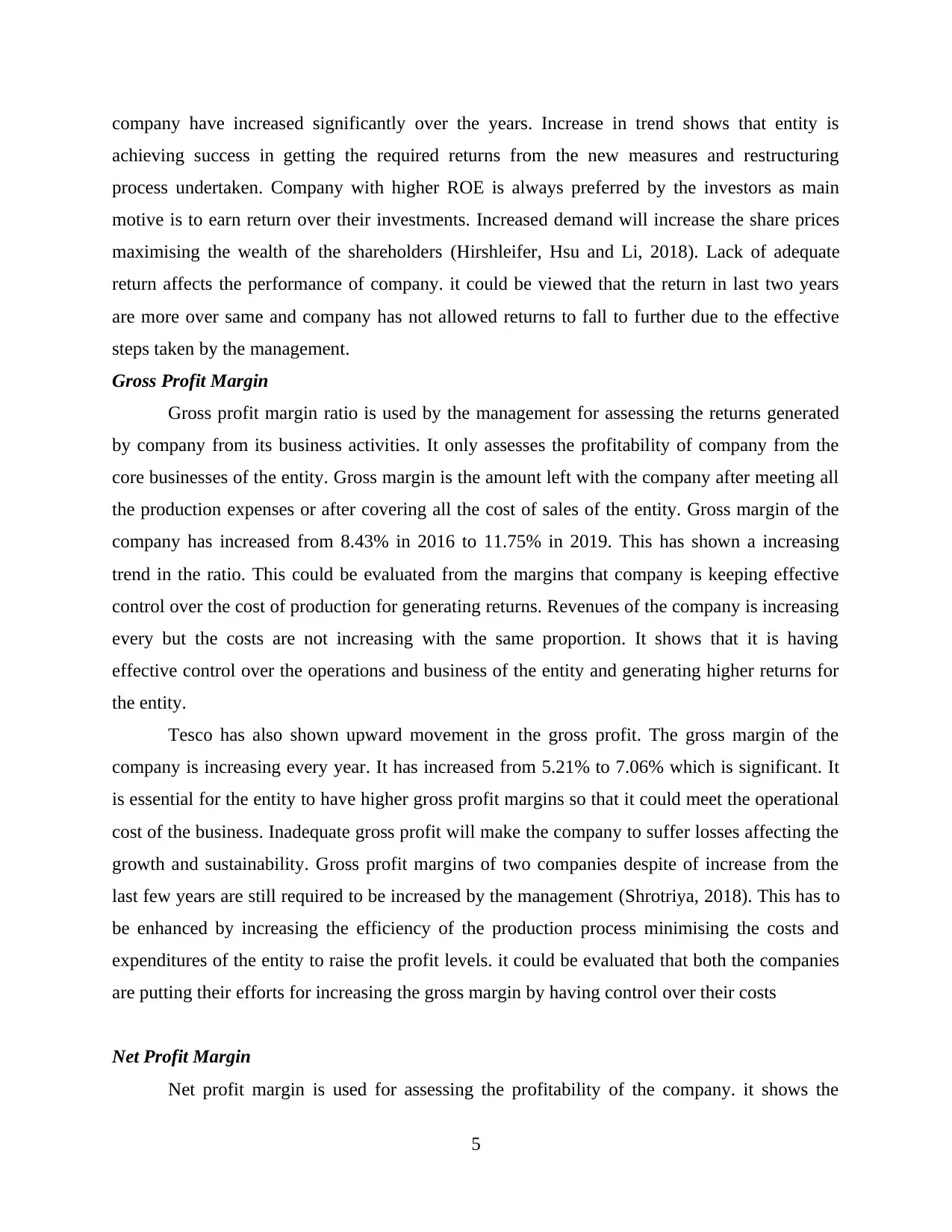
company have increased significantly over the years. Increase in trend shows that entity is
achieving success in getting the required returns from the new measures and restructuring
process undertaken. Company with higher ROE is always preferred by the investors as main
motive is to earn return over their investments. Increased demand will increase the share prices
maximising the wealth of the shareholders (Hirshleifer, Hsu and Li, 2018). Lack of adequate
return affects the performance of company. it could be viewed that the return in last two years
are more over same and company has not allowed returns to fall to further due to the effective
steps taken by the management.
Gross Profit Margin
Gross profit margin ratio is used by the management for assessing the returns generated
by company from its business activities. It only assesses the profitability of company from the
core businesses of the entity. Gross margin is the amount left with the company after meeting all
the production expenses or after covering all the cost of sales of the entity. Gross margin of the
company has increased from 8.43% in 2016 to 11.75% in 2019. This has shown a increasing
trend in the ratio. This could be evaluated from the margins that company is keeping effective
control over the cost of production for generating returns. Revenues of the company is increasing
every but the costs are not increasing with the same proportion. It shows that it is having
effective control over the operations and business of the entity and generating higher returns for
the entity.
Tesco has also shown upward movement in the gross profit. The gross margin of the
company is increasing every year. It has increased from 5.21% to 7.06% which is significant. It
is essential for the entity to have higher gross profit margins so that it could meet the operational
cost of the business. Inadequate gross profit will make the company to suffer losses affecting the
growth and sustainability. Gross profit margins of two companies despite of increase from the
last few years are still required to be increased by the management (Shrotriya, 2018). This has to
be enhanced by increasing the efficiency of the production process minimising the costs and
expenditures of the entity to raise the profit levels. it could be evaluated that both the companies
are putting their efforts for increasing the gross margin by having control over their costs
Net Profit Margin
Net profit margin is used for assessing the profitability of the company. it shows the
5
achieving success in getting the required returns from the new measures and restructuring
process undertaken. Company with higher ROE is always preferred by the investors as main
motive is to earn return over their investments. Increased demand will increase the share prices
maximising the wealth of the shareholders (Hirshleifer, Hsu and Li, 2018). Lack of adequate
return affects the performance of company. it could be viewed that the return in last two years
are more over same and company has not allowed returns to fall to further due to the effective
steps taken by the management.
Gross Profit Margin
Gross profit margin ratio is used by the management for assessing the returns generated
by company from its business activities. It only assesses the profitability of company from the
core businesses of the entity. Gross margin is the amount left with the company after meeting all
the production expenses or after covering all the cost of sales of the entity. Gross margin of the
company has increased from 8.43% in 2016 to 11.75% in 2019. This has shown a increasing
trend in the ratio. This could be evaluated from the margins that company is keeping effective
control over the cost of production for generating returns. Revenues of the company is increasing
every but the costs are not increasing with the same proportion. It shows that it is having
effective control over the operations and business of the entity and generating higher returns for
the entity.
Tesco has also shown upward movement in the gross profit. The gross margin of the
company is increasing every year. It has increased from 5.21% to 7.06% which is significant. It
is essential for the entity to have higher gross profit margins so that it could meet the operational
cost of the business. Inadequate gross profit will make the company to suffer losses affecting the
growth and sustainability. Gross profit margins of two companies despite of increase from the
last few years are still required to be increased by the management (Shrotriya, 2018). This has to
be enhanced by increasing the efficiency of the production process minimising the costs and
expenditures of the entity to raise the profit levels. it could be evaluated that both the companies
are putting their efforts for increasing the gross margin by having control over their costs
Net Profit Margin
Net profit margin is used for assessing the profitability of the company. it shows the
5
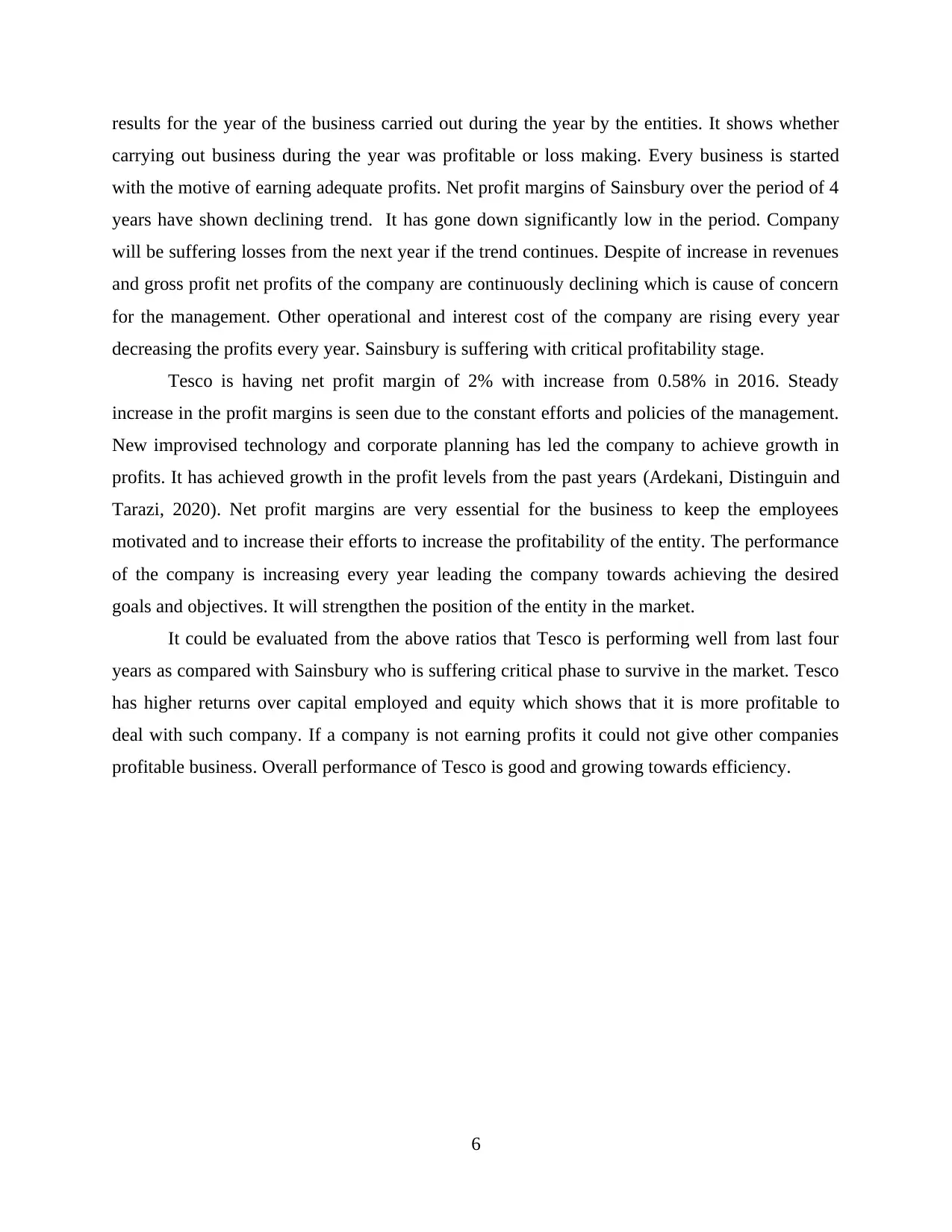
results for the year of the business carried out during the year by the entities. It shows whether
carrying out business during the year was profitable or loss making. Every business is started
with the motive of earning adequate profits. Net profit margins of Sainsbury over the period of 4
years have shown declining trend. It has gone down significantly low in the period. Company
will be suffering losses from the next year if the trend continues. Despite of increase in revenues
and gross profit net profits of the company are continuously declining which is cause of concern
for the management. Other operational and interest cost of the company are rising every year
decreasing the profits every year. Sainsbury is suffering with critical profitability stage.
Tesco is having net profit margin of 2% with increase from 0.58% in 2016. Steady
increase in the profit margins is seen due to the constant efforts and policies of the management.
New improvised technology and corporate planning has led the company to achieve growth in
profits. It has achieved growth in the profit levels from the past years (Ardekani, Distinguin and
Tarazi, 2020). Net profit margins are very essential for the business to keep the employees
motivated and to increase their efforts to increase the profitability of the entity. The performance
of the company is increasing every year leading the company towards achieving the desired
goals and objectives. It will strengthen the position of the entity in the market.
It could be evaluated from the above ratios that Tesco is performing well from last four
years as compared with Sainsbury who is suffering critical phase to survive in the market. Tesco
has higher returns over capital employed and equity which shows that it is more profitable to
deal with such company. If a company is not earning profits it could not give other companies
profitable business. Overall performance of Tesco is good and growing towards efficiency.
6
carrying out business during the year was profitable or loss making. Every business is started
with the motive of earning adequate profits. Net profit margins of Sainsbury over the period of 4
years have shown declining trend. It has gone down significantly low in the period. Company
will be suffering losses from the next year if the trend continues. Despite of increase in revenues
and gross profit net profits of the company are continuously declining which is cause of concern
for the management. Other operational and interest cost of the company are rising every year
decreasing the profits every year. Sainsbury is suffering with critical profitability stage.
Tesco is having net profit margin of 2% with increase from 0.58% in 2016. Steady
increase in the profit margins is seen due to the constant efforts and policies of the management.
New improvised technology and corporate planning has led the company to achieve growth in
profits. It has achieved growth in the profit levels from the past years (Ardekani, Distinguin and
Tarazi, 2020). Net profit margins are very essential for the business to keep the employees
motivated and to increase their efforts to increase the profitability of the entity. The performance
of the company is increasing every year leading the company towards achieving the desired
goals and objectives. It will strengthen the position of the entity in the market.
It could be evaluated from the above ratios that Tesco is performing well from last four
years as compared with Sainsbury who is suffering critical phase to survive in the market. Tesco
has higher returns over capital employed and equity which shows that it is more profitable to
deal with such company. If a company is not earning profits it could not give other companies
profitable business. Overall performance of Tesco is good and growing towards efficiency.
6
⊘ This is a preview!⊘
Do you want full access?
Subscribe today to unlock all pages.

Trusted by 1+ million students worldwide
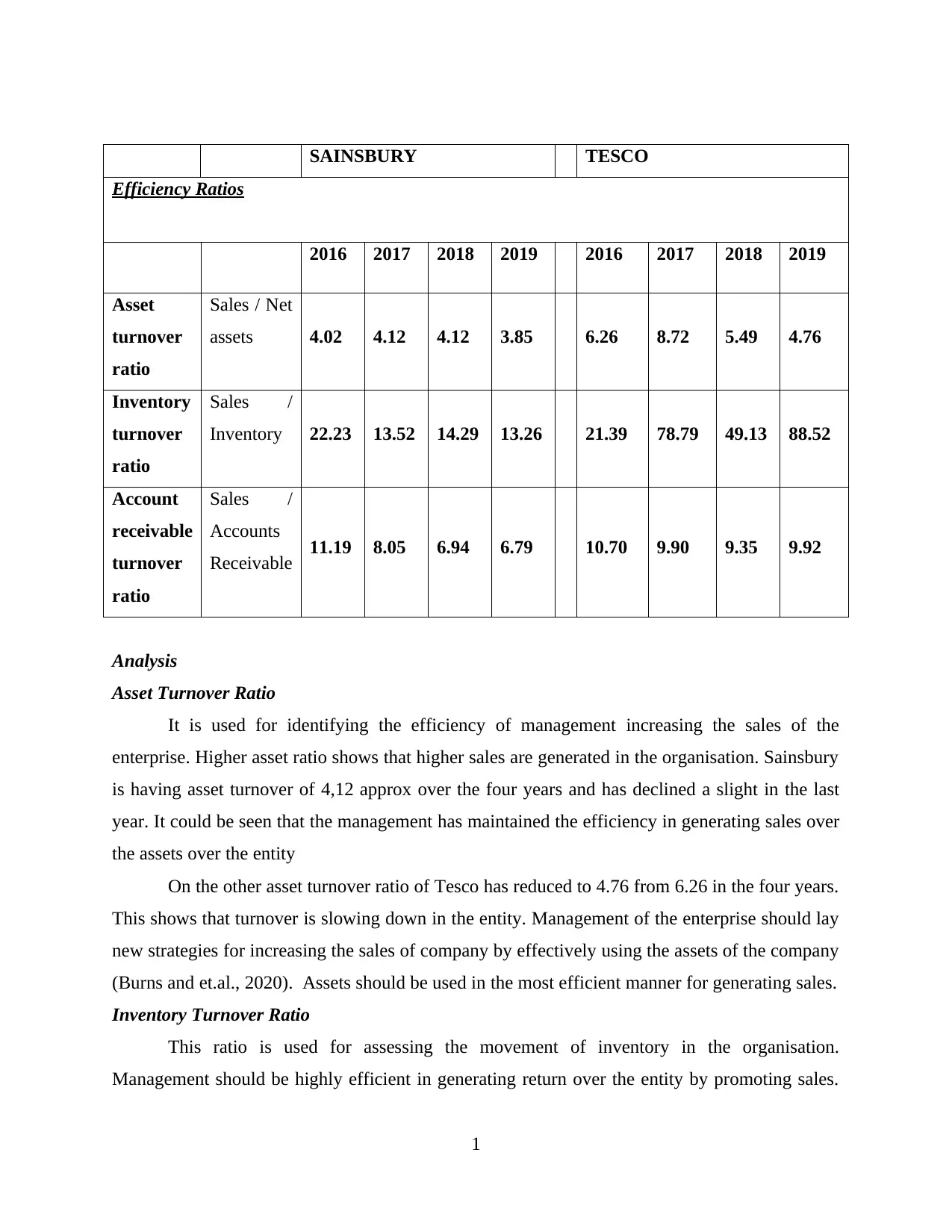
SAINSBURY TESCO
Efficiency Ratios
2016 2017 2018 2019 2016 2017 2018 2019
Asset
turnover
ratio
Sales / Net
assets 4.02 4.12 4.12 3.85 6.26 8.72 5.49 4.76
Inventory
turnover
ratio
Sales /
Inventory 22.23 13.52 14.29 13.26 21.39 78.79 49.13 88.52
Account
receivable
turnover
ratio
Sales /
Accounts
Receivable 11.19 8.05 6.94 6.79 10.70 9.90 9.35 9.92
Analysis
Asset Turnover Ratio
It is used for identifying the efficiency of management increasing the sales of the
enterprise. Higher asset ratio shows that higher sales are generated in the organisation. Sainsbury
is having asset turnover of 4,12 approx over the four years and has declined a slight in the last
year. It could be seen that the management has maintained the efficiency in generating sales over
the assets over the entity
On the other asset turnover ratio of Tesco has reduced to 4.76 from 6.26 in the four years.
This shows that turnover is slowing down in the entity. Management of the enterprise should lay
new strategies for increasing the sales of company by effectively using the assets of the company
(Burns and et.al., 2020). Assets should be used in the most efficient manner for generating sales.
Inventory Turnover Ratio
This ratio is used for assessing the movement of inventory in the organisation.
Management should be highly efficient in generating return over the entity by promoting sales.
1
Efficiency Ratios
2016 2017 2018 2019 2016 2017 2018 2019
Asset
turnover
ratio
Sales / Net
assets 4.02 4.12 4.12 3.85 6.26 8.72 5.49 4.76
Inventory
turnover
ratio
Sales /
Inventory 22.23 13.52 14.29 13.26 21.39 78.79 49.13 88.52
Account
receivable
turnover
ratio
Sales /
Accounts
Receivable 11.19 8.05 6.94 6.79 10.70 9.90 9.35 9.92
Analysis
Asset Turnover Ratio
It is used for identifying the efficiency of management increasing the sales of the
enterprise. Higher asset ratio shows that higher sales are generated in the organisation. Sainsbury
is having asset turnover of 4,12 approx over the four years and has declined a slight in the last
year. It could be seen that the management has maintained the efficiency in generating sales over
the assets over the entity
On the other asset turnover ratio of Tesco has reduced to 4.76 from 6.26 in the four years.
This shows that turnover is slowing down in the entity. Management of the enterprise should lay
new strategies for increasing the sales of company by effectively using the assets of the company
(Burns and et.al., 2020). Assets should be used in the most efficient manner for generating sales.
Inventory Turnover Ratio
This ratio is used for assessing the movement of inventory in the organisation.
Management should be highly efficient in generating return over the entity by promoting sales.
1
Paraphrase This Document
Need a fresh take? Get an instant paraphrase of this document with our AI Paraphraser
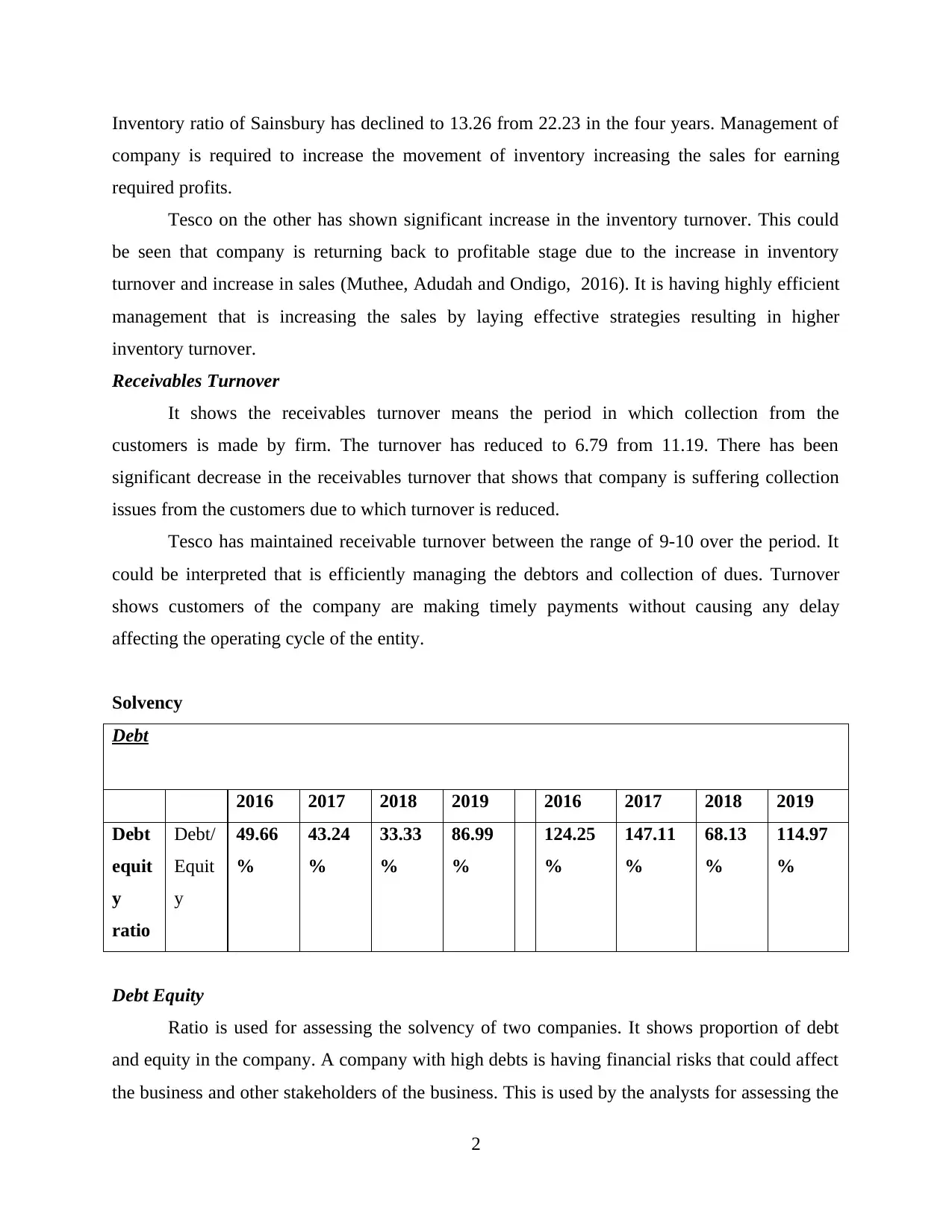
Inventory ratio of Sainsbury has declined to 13.26 from 22.23 in the four years. Management of
company is required to increase the movement of inventory increasing the sales for earning
required profits.
Tesco on the other has shown significant increase in the inventory turnover. This could
be seen that company is returning back to profitable stage due to the increase in inventory
turnover and increase in sales (Muthee, Adudah and Ondigo, 2016). It is having highly efficient
management that is increasing the sales by laying effective strategies resulting in higher
inventory turnover.
Receivables Turnover
It shows the receivables turnover means the period in which collection from the
customers is made by firm. The turnover has reduced to 6.79 from 11.19. There has been
significant decrease in the receivables turnover that shows that company is suffering collection
issues from the customers due to which turnover is reduced.
Tesco has maintained receivable turnover between the range of 9-10 over the period. It
could be interpreted that is efficiently managing the debtors and collection of dues. Turnover
shows customers of the company are making timely payments without causing any delay
affecting the operating cycle of the entity.
Solvency
Debt
2016 2017 2018 2019 2016 2017 2018 2019
Debt
equit
y
ratio
Debt/
Equit
y
49.66
%
43.24
%
33.33
%
86.99
%
124.25
%
147.11
%
68.13
%
114.97
%
Debt Equity
Ratio is used for assessing the solvency of two companies. It shows proportion of debt
and equity in the company. A company with high debts is having financial risks that could affect
the business and other stakeholders of the business. This is used by the analysts for assessing the
2
company is required to increase the movement of inventory increasing the sales for earning
required profits.
Tesco on the other has shown significant increase in the inventory turnover. This could
be seen that company is returning back to profitable stage due to the increase in inventory
turnover and increase in sales (Muthee, Adudah and Ondigo, 2016). It is having highly efficient
management that is increasing the sales by laying effective strategies resulting in higher
inventory turnover.
Receivables Turnover
It shows the receivables turnover means the period in which collection from the
customers is made by firm. The turnover has reduced to 6.79 from 11.19. There has been
significant decrease in the receivables turnover that shows that company is suffering collection
issues from the customers due to which turnover is reduced.
Tesco has maintained receivable turnover between the range of 9-10 over the period. It
could be interpreted that is efficiently managing the debtors and collection of dues. Turnover
shows customers of the company are making timely payments without causing any delay
affecting the operating cycle of the entity.
Solvency
Debt
2016 2017 2018 2019 2016 2017 2018 2019
Debt
equit
y
ratio
Debt/
Equit
y
49.66
%
43.24
%
33.33
%
86.99
%
124.25
%
147.11
%
68.13
%
114.97
%
Debt Equity
Ratio is used for assessing the solvency of two companies. It shows proportion of debt
and equity in the company. A company with high debts is having financial risks that could affect
the business and other stakeholders of the business. This is used by the analysts for assessing the
2
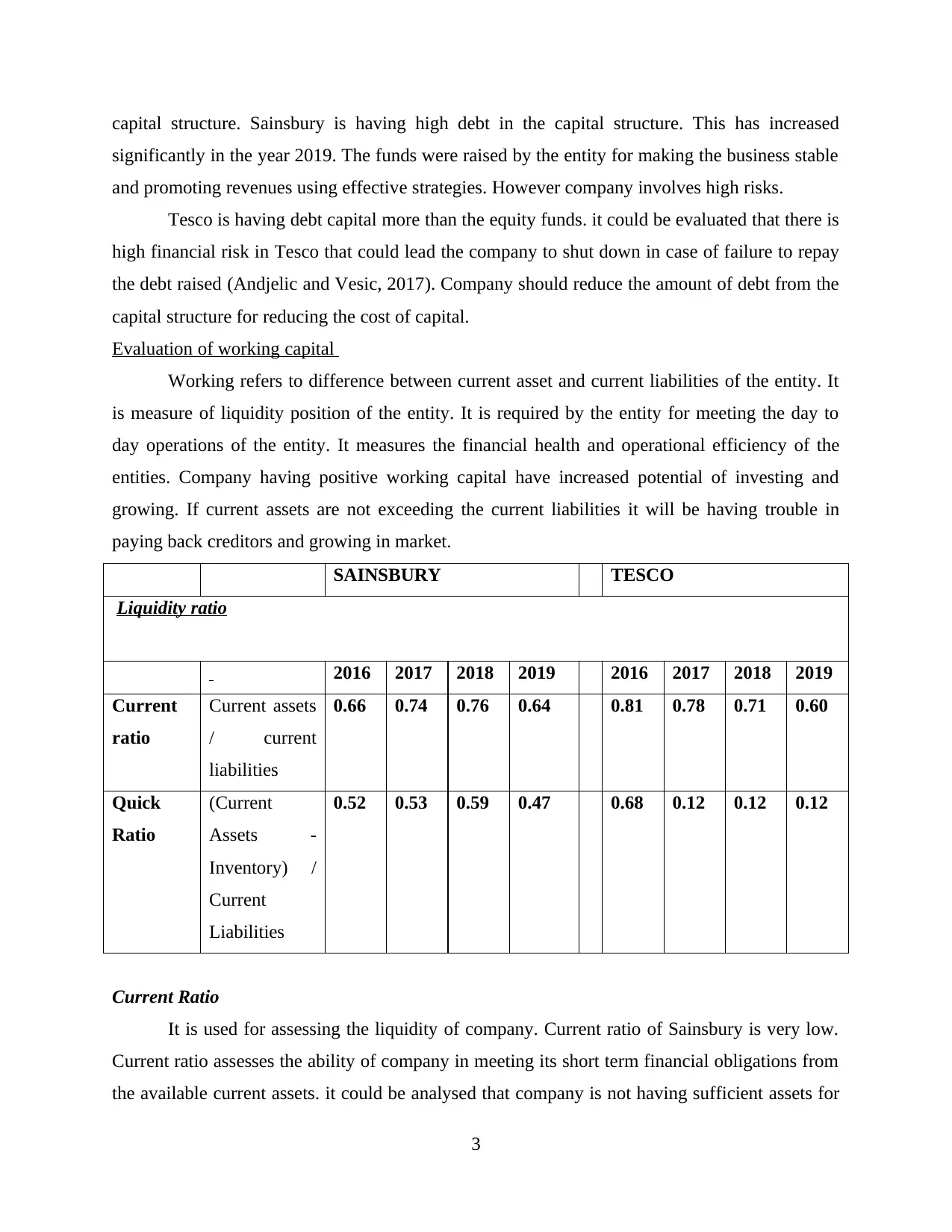
capital structure. Sainsbury is having high debt in the capital structure. This has increased
significantly in the year 2019. The funds were raised by the entity for making the business stable
and promoting revenues using effective strategies. However company involves high risks.
Tesco is having debt capital more than the equity funds. it could be evaluated that there is
high financial risk in Tesco that could lead the company to shut down in case of failure to repay
the debt raised (Andjelic and Vesic, 2017). Company should reduce the amount of debt from the
capital structure for reducing the cost of capital.
Evaluation of working capital
Working refers to difference between current asset and current liabilities of the entity. It
is measure of liquidity position of the entity. It is required by the entity for meeting the day to
day operations of the entity. It measures the financial health and operational efficiency of the
entities. Company having positive working capital have increased potential of investing and
growing. If current assets are not exceeding the current liabilities it will be having trouble in
paying back creditors and growing in market.
SAINSBURY TESCO
Liquidity ratio
2016 2017 2018 2019 2016 2017 2018 2019
Current
ratio
Current assets
/ current
liabilities
0.66 0.74 0.76 0.64 0.81 0.78 0.71 0.60
Quick
Ratio
(Current
Assets -
Inventory) /
Current
Liabilities
0.52 0.53 0.59 0.47 0.68 0.12 0.12 0.12
Current Ratio
It is used for assessing the liquidity of company. Current ratio of Sainsbury is very low.
Current ratio assesses the ability of company in meeting its short term financial obligations from
the available current assets. it could be analysed that company is not having sufficient assets for
3
significantly in the year 2019. The funds were raised by the entity for making the business stable
and promoting revenues using effective strategies. However company involves high risks.
Tesco is having debt capital more than the equity funds. it could be evaluated that there is
high financial risk in Tesco that could lead the company to shut down in case of failure to repay
the debt raised (Andjelic and Vesic, 2017). Company should reduce the amount of debt from the
capital structure for reducing the cost of capital.
Evaluation of working capital
Working refers to difference between current asset and current liabilities of the entity. It
is measure of liquidity position of the entity. It is required by the entity for meeting the day to
day operations of the entity. It measures the financial health and operational efficiency of the
entities. Company having positive working capital have increased potential of investing and
growing. If current assets are not exceeding the current liabilities it will be having trouble in
paying back creditors and growing in market.
SAINSBURY TESCO
Liquidity ratio
2016 2017 2018 2019 2016 2017 2018 2019
Current
ratio
Current assets
/ current
liabilities
0.66 0.74 0.76 0.64 0.81 0.78 0.71 0.60
Quick
Ratio
(Current
Assets -
Inventory) /
Current
Liabilities
0.52 0.53 0.59 0.47 0.68 0.12 0.12 0.12
Current Ratio
It is used for assessing the liquidity of company. Current ratio of Sainsbury is very low.
Current ratio assesses the ability of company in meeting its short term financial obligations from
the available current assets. it could be analysed that company is not having sufficient assets for
3
⊘ This is a preview!⊘
Do you want full access?
Subscribe today to unlock all pages.

Trusted by 1+ million students worldwide
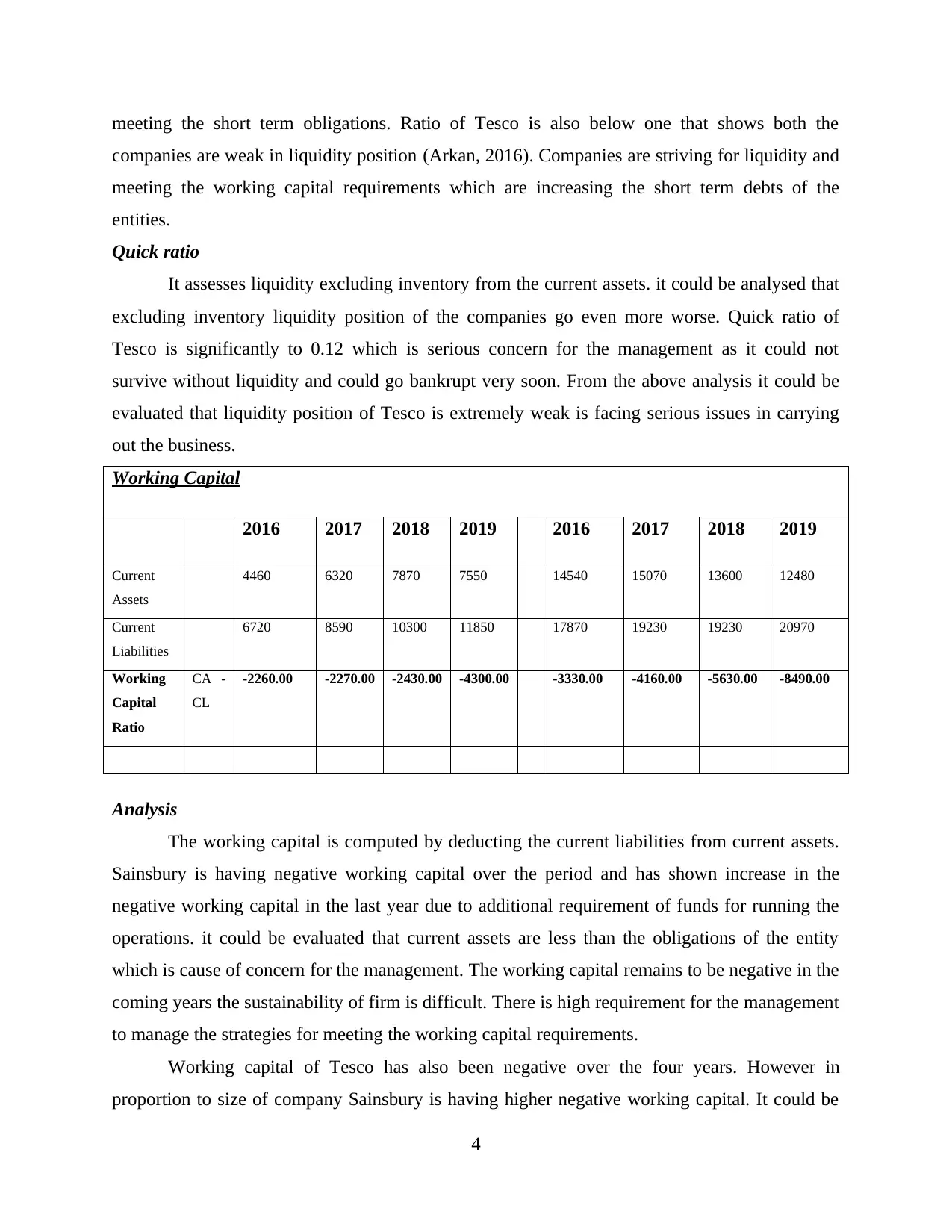
meeting the short term obligations. Ratio of Tesco is also below one that shows both the
companies are weak in liquidity position (Arkan, 2016). Companies are striving for liquidity and
meeting the working capital requirements which are increasing the short term debts of the
entities.
Quick ratio
It assesses liquidity excluding inventory from the current assets. it could be analysed that
excluding inventory liquidity position of the companies go even more worse. Quick ratio of
Tesco is significantly to 0.12 which is serious concern for the management as it could not
survive without liquidity and could go bankrupt very soon. From the above analysis it could be
evaluated that liquidity position of Tesco is extremely weak is facing serious issues in carrying
out the business.
Working Capital
2016 2017 2018 2019 2016 2017 2018 2019
Current
Assets
4460 6320 7870 7550 14540 15070 13600 12480
Current
Liabilities
6720 8590 10300 11850 17870 19230 19230 20970
Working
Capital
Ratio
CA -
CL
-2260.00 -2270.00 -2430.00 -4300.00 -3330.00 -4160.00 -5630.00 -8490.00
Analysis
The working capital is computed by deducting the current liabilities from current assets.
Sainsbury is having negative working capital over the period and has shown increase in the
negative working capital in the last year due to additional requirement of funds for running the
operations. it could be evaluated that current assets are less than the obligations of the entity
which is cause of concern for the management. The working capital remains to be negative in the
coming years the sustainability of firm is difficult. There is high requirement for the management
to manage the strategies for meeting the working capital requirements.
Working capital of Tesco has also been negative over the four years. However in
proportion to size of company Sainsbury is having higher negative working capital. It could be
4
companies are weak in liquidity position (Arkan, 2016). Companies are striving for liquidity and
meeting the working capital requirements which are increasing the short term debts of the
entities.
Quick ratio
It assesses liquidity excluding inventory from the current assets. it could be analysed that
excluding inventory liquidity position of the companies go even more worse. Quick ratio of
Tesco is significantly to 0.12 which is serious concern for the management as it could not
survive without liquidity and could go bankrupt very soon. From the above analysis it could be
evaluated that liquidity position of Tesco is extremely weak is facing serious issues in carrying
out the business.
Working Capital
2016 2017 2018 2019 2016 2017 2018 2019
Current
Assets
4460 6320 7870 7550 14540 15070 13600 12480
Current
Liabilities
6720 8590 10300 11850 17870 19230 19230 20970
Working
Capital
Ratio
CA -
CL
-2260.00 -2270.00 -2430.00 -4300.00 -3330.00 -4160.00 -5630.00 -8490.00
Analysis
The working capital is computed by deducting the current liabilities from current assets.
Sainsbury is having negative working capital over the period and has shown increase in the
negative working capital in the last year due to additional requirement of funds for running the
operations. it could be evaluated that current assets are less than the obligations of the entity
which is cause of concern for the management. The working capital remains to be negative in the
coming years the sustainability of firm is difficult. There is high requirement for the management
to manage the strategies for meeting the working capital requirements.
Working capital of Tesco has also been negative over the four years. However in
proportion to size of company Sainsbury is having higher negative working capital. It could be
4
Paraphrase This Document
Need a fresh take? Get an instant paraphrase of this document with our AI Paraphraser
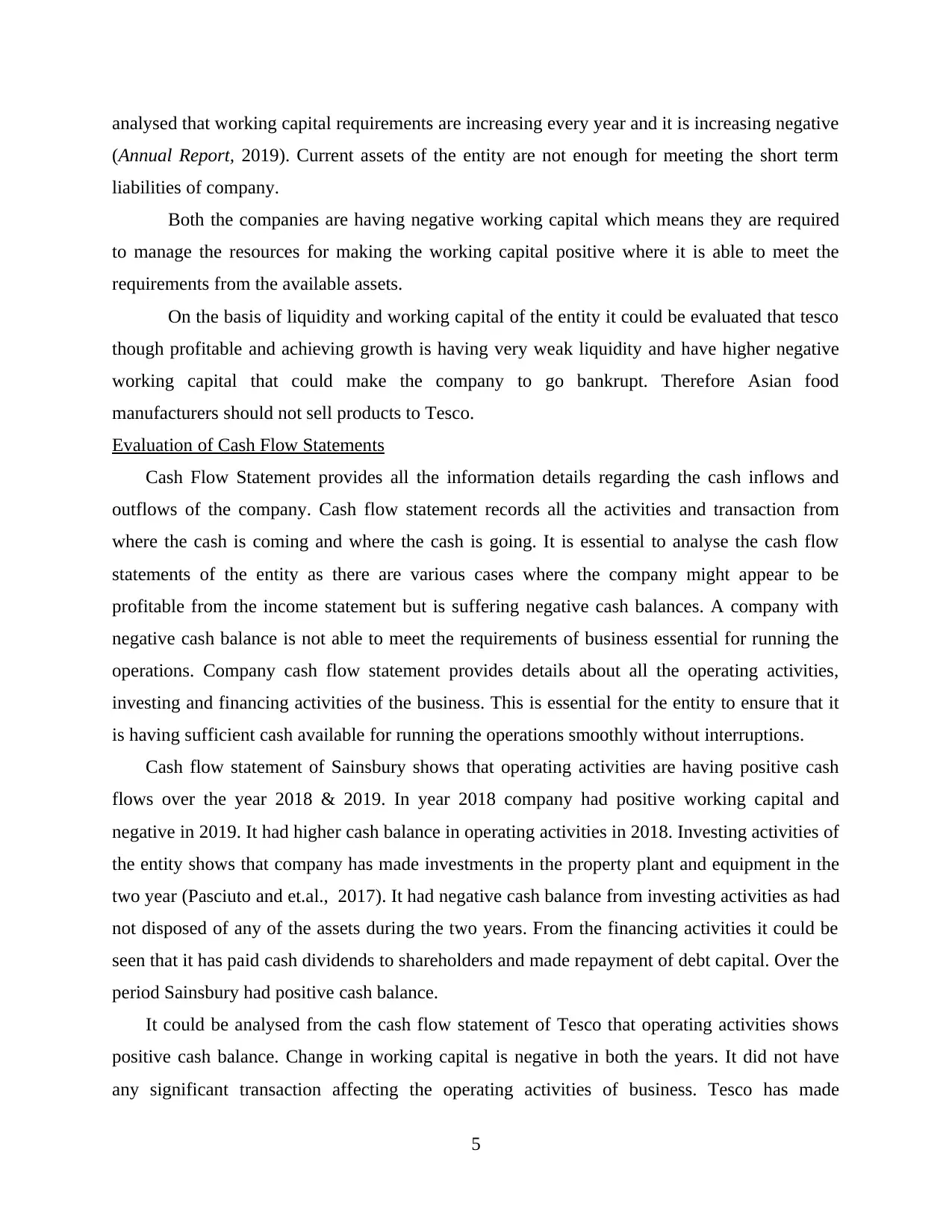
analysed that working capital requirements are increasing every year and it is increasing negative
(Annual Report, 2019). Current assets of the entity are not enough for meeting the short term
liabilities of company.
Both the companies are having negative working capital which means they are required
to manage the resources for making the working capital positive where it is able to meet the
requirements from the available assets.
On the basis of liquidity and working capital of the entity it could be evaluated that tesco
though profitable and achieving growth is having very weak liquidity and have higher negative
working capital that could make the company to go bankrupt. Therefore Asian food
manufacturers should not sell products to Tesco.
Evaluation of Cash Flow Statements
Cash Flow Statement provides all the information details regarding the cash inflows and
outflows of the company. Cash flow statement records all the activities and transaction from
where the cash is coming and where the cash is going. It is essential to analyse the cash flow
statements of the entity as there are various cases where the company might appear to be
profitable from the income statement but is suffering negative cash balances. A company with
negative cash balance is not able to meet the requirements of business essential for running the
operations. Company cash flow statement provides details about all the operating activities,
investing and financing activities of the business. This is essential for the entity to ensure that it
is having sufficient cash available for running the operations smoothly without interruptions.
Cash flow statement of Sainsbury shows that operating activities are having positive cash
flows over the year 2018 & 2019. In year 2018 company had positive working capital and
negative in 2019. It had higher cash balance in operating activities in 2018. Investing activities of
the entity shows that company has made investments in the property plant and equipment in the
two year (Pasciuto and et.al., 2017). It had negative cash balance from investing activities as had
not disposed of any of the assets during the two years. From the financing activities it could be
seen that it has paid cash dividends to shareholders and made repayment of debt capital. Over the
period Sainsbury had positive cash balance.
It could be analysed from the cash flow statement of Tesco that operating activities shows
positive cash balance. Change in working capital is negative in both the years. It did not have
any significant transaction affecting the operating activities of business. Tesco has made
5
(Annual Report, 2019). Current assets of the entity are not enough for meeting the short term
liabilities of company.
Both the companies are having negative working capital which means they are required
to manage the resources for making the working capital positive where it is able to meet the
requirements from the available assets.
On the basis of liquidity and working capital of the entity it could be evaluated that tesco
though profitable and achieving growth is having very weak liquidity and have higher negative
working capital that could make the company to go bankrupt. Therefore Asian food
manufacturers should not sell products to Tesco.
Evaluation of Cash Flow Statements
Cash Flow Statement provides all the information details regarding the cash inflows and
outflows of the company. Cash flow statement records all the activities and transaction from
where the cash is coming and where the cash is going. It is essential to analyse the cash flow
statements of the entity as there are various cases where the company might appear to be
profitable from the income statement but is suffering negative cash balances. A company with
negative cash balance is not able to meet the requirements of business essential for running the
operations. Company cash flow statement provides details about all the operating activities,
investing and financing activities of the business. This is essential for the entity to ensure that it
is having sufficient cash available for running the operations smoothly without interruptions.
Cash flow statement of Sainsbury shows that operating activities are having positive cash
flows over the year 2018 & 2019. In year 2018 company had positive working capital and
negative in 2019. It had higher cash balance in operating activities in 2018. Investing activities of
the entity shows that company has made investments in the property plant and equipment in the
two year (Pasciuto and et.al., 2017). It had negative cash balance from investing activities as had
not disposed of any of the assets during the two years. From the financing activities it could be
seen that it has paid cash dividends to shareholders and made repayment of debt capital. Over the
period Sainsbury had positive cash balance.
It could be analysed from the cash flow statement of Tesco that operating activities shows
positive cash balance. Change in working capital is negative in both the years. It did not have
any significant transaction affecting the operating activities of business. Tesco has made
5
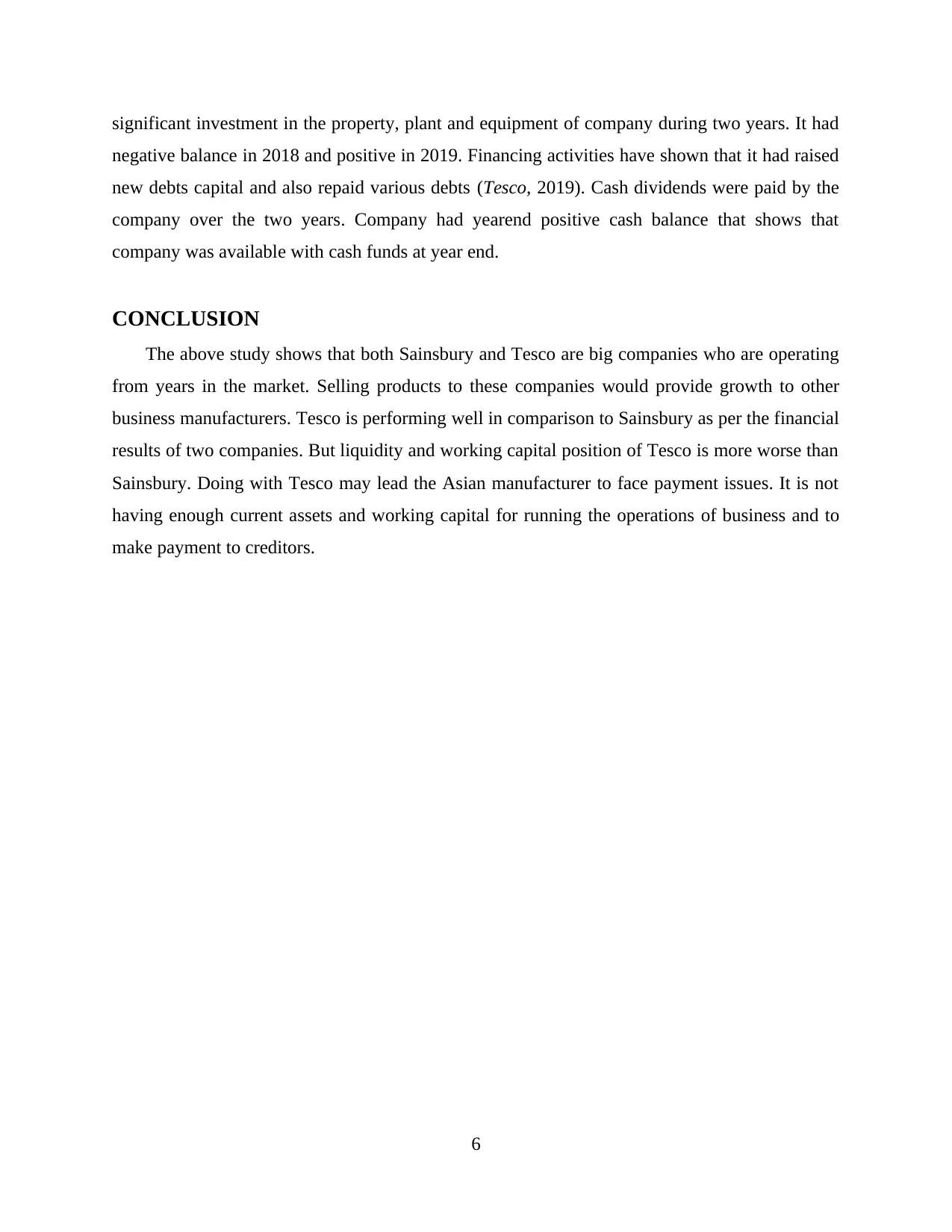
significant investment in the property, plant and equipment of company during two years. It had
negative balance in 2018 and positive in 2019. Financing activities have shown that it had raised
new debts capital and also repaid various debts (Tesco, 2019). Cash dividends were paid by the
company over the two years. Company had yearend positive cash balance that shows that
company was available with cash funds at year end.
CONCLUSION
The above study shows that both Sainsbury and Tesco are big companies who are operating
from years in the market. Selling products to these companies would provide growth to other
business manufacturers. Tesco is performing well in comparison to Sainsbury as per the financial
results of two companies. But liquidity and working capital position of Tesco is more worse than
Sainsbury. Doing with Tesco may lead the Asian manufacturer to face payment issues. It is not
having enough current assets and working capital for running the operations of business and to
make payment to creditors.
6
negative balance in 2018 and positive in 2019. Financing activities have shown that it had raised
new debts capital and also repaid various debts (Tesco, 2019). Cash dividends were paid by the
company over the two years. Company had yearend positive cash balance that shows that
company was available with cash funds at year end.
CONCLUSION
The above study shows that both Sainsbury and Tesco are big companies who are operating
from years in the market. Selling products to these companies would provide growth to other
business manufacturers. Tesco is performing well in comparison to Sainsbury as per the financial
results of two companies. But liquidity and working capital position of Tesco is more worse than
Sainsbury. Doing with Tesco may lead the Asian manufacturer to face payment issues. It is not
having enough current assets and working capital for running the operations of business and to
make payment to creditors.
6
⊘ This is a preview!⊘
Do you want full access?
Subscribe today to unlock all pages.

Trusted by 1+ million students worldwide
1 out of 19
Related Documents
Your All-in-One AI-Powered Toolkit for Academic Success.
+13062052269
info@desklib.com
Available 24*7 on WhatsApp / Email
![[object Object]](/_next/static/media/star-bottom.7253800d.svg)
Unlock your academic potential
Copyright © 2020–2025 A2Z Services. All Rights Reserved. Developed and managed by ZUCOL.





